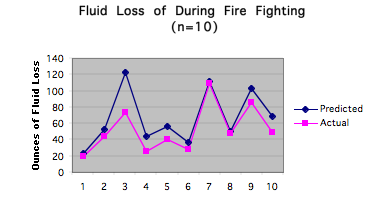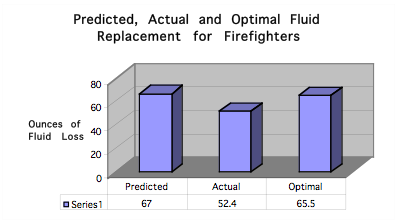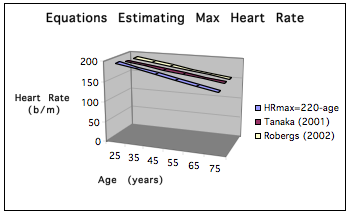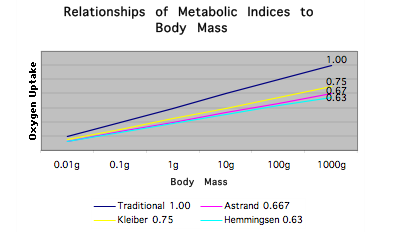The measurement of the rate at which oxygen is consumed can provide valuable information as it pertains to assessing levels of cardiorespiratory fitness, estimating calories burned during activity, and estimating physiological mechanisms related to metabolic function such as the prediction of fluid replacement during physical activity. The purpose of this paper is to provide a means to predict fluid loss taking into account the physiological dimensions, work intensity, exercise mode, temperature, and humidity factors involved in the occupation of firefighting.
A number of testing protocols that have attempted to estimate fluid loss during physical activity based on the heart rate response to submaximal workloads. By extrapolating the slope of the fluid loss rate/workload relationship to an estimated maximal heart rate, rates of fluid loss across all exercise intensities can be estimated. A substantial source of error in predicting fluid loss accurately appears to be in the estimation of maximal heart rate, with errors as high as 10-20% when extrapolating from submaximal data. (McArdle, 1981).
The widespread use of scientifically unsupported equations is reviewed by Robergs and Landwehr, who analyzed 30 empirically derived equations to construct the average regression equation: 208.754 – 0.734(age) to estimate maximum heart rate. This most closely matched equation is by Tanaka (2001) at: 208 – 0.70(age) for healthy adults with a correlation of r = 0.81.
Figure 1: Similar results are noted in the scientifically derived equations by Tanaka {208-0.7(age)} and Robergs {208.754-0.734(age)}, while the 220-age equation tends to underestimate maximal heart rates of older subjects.
By using more accurate equations for estimating maximum heart rate, more accurate exercise intensities can be utilized with more accurate estimates of fluid loss.
The Heart rate Reserve Method, derived by Karvonen (1957), calculates the difference between the resting heart rate and the maximum heart rate and refers to this as the heart rate reserve. Burke (2001), and Heyward (1997) stated the Heart Rate Reserve Method had a nearly direct correlation to percent VO2. Thus, by accepting the premise that the percent of the Heart Rate Reserve is a more direct correlate with percent Max VO2, a less complicated system of utilizing exercise intensity for predicting caloric consumption and fluid loss was can be realized.
Effect of Body Dimension
A subject of twice the weight does not have twice the blood volume, or lung capacity of a person half their body weight. VonDobeln, Astrand & Bergstrom (1966) were early pioneers in research on body dimensions and the effect on the measurement of oxygen uptake. VonDobeln published a comprehensive review of factors related to oxygen uptake, and found measurement of body size did not contribute to the prediction of max VO2. It was interesting to note the lack of diversity in the weights of the study population, averaging 76.3 kg, (SD= 7.66 kg). It is quite possible the lack of a diverse study population in terms of mass may have stalled future physiological research on body dimensions and the effect on oxygen uptake by other investigators. Early work by Hill (1950) found that work (i.e. force and power), are two dimensional or squared quantities, while mass and volume measurements are three dimensional or cubed quantities.  Thus, when analyzing force (F2) to mass (M3) ratios, the investigator must adopt a 2/3 exponent into the units of measurement. Instead of measuring strength as force per kilo or oxygen consumption in ml/kg, Hill postulated that relative strength and endurance is more related to the mass of the subject raised to a 2/3 exponent.
Renowned exercise physiologist, Per-Olof Astrand, was first to note the disadvantage of using ml/kg units in the assessment of maximal aerobic power. Astrand stated that “maximal oxygen uptake, expressed as ml * min –1 * kg –2/3, is not related to body weight, and may therefore be used as a meaningful fitness index instead of conventional methods of expressing maximal oxygen uptake as ml * kg –1, which penalizes heavy individuals.†(1977, p. 377).
This was consistent with the research of McMahon and Bonner (1983), examining the relationship of body mass to oxygen consumption in guinea pigs. O. Vaage and Hermansen (1977) found that in similarly trained elite athletes, the deviation from a perfect 2/3 predictive relationship between mass and oxygen uptake, was 0.86 when plotted against liters of oxygen uptake per minute, (bigger athletes had higher absolute consumption), the deviation was -.69 when plotted against ml/kg*min-1 (smaller athletes had higher relative consumption) and –.06 when plotted against ml/kg^2/3 per minute. Athletes, regardless of size, did not deviate far from the predicted 2/3 relationship.
Mass as it Relates to Basal Metabolic Rate
Research conducted by Kleiber (1932), showed that for mammals of different body dimensions, basal metabolic rate held a consistent scaling to the power of 3/4, rather than a 2/3 exponent when analyzed across the range of dimensions from a mouse to an elephant. Kleiber originally postulated that the 3/4 relationship for basal metabolism was valid across a variety of species, but within the species it may be closer to 2/3. But McMahon & Bonner, noted in species having larger variances of body mass such as dogs, the individual species slope is close to 0.75.
Instead of relating mass to force or power, as when the animal is engaged in activity, Kleiber’s Law found consistency with the theory of elastic similarity. The theory of elastic similarity simply stated “predicts that the cross-sectional area of any anatomical feature of the body is proportional to mass 3/4†(McMahon & Bonner, p. 130).  So the cross sectional area of the body segments in proportion to mass may be the determining factor in estimating basal metabolism. Brody (1945), verified the experiments of Kleiber, finding a similar relationship raised to the .74 power.
The information provided by Kleiber and Astrand infers the relationship between mass and oxygen uptake may change from a slope of 3/4 in basal conditions to a 2/3 slope at maximal oxygen uptake. This appears to make intuitive sense. When in a resting state, the volume of the skeletal voluntary muscle mass is dormant, while the autonomic system, is always metabolically active.  As exercise intensities increase, blood may be shunted away from the organs and smooth muscles into the more dynamic and active working muscles. The basal metabolic contribution to the total oxygen uptake is altered, thus reflecting the noted change seen in its relationship to body mass. This could explain the shift of the slope from 3/4, in basal conditions as proposed by Brody and Kleiber, to the 2/3 proposed by Vaage & Hermansen, and Astrand during maximal aerobic exercise.
Body Surface Area as it Relates to Metabolic Rate
Another factor involved in the limitation of peak exercise performance and oxygen uptake is the dissipation of heat. This was first noted by the German physiologist Max Rubner (1883) who suggested that metabolic rate was somehow limited by the body’s surface area. It was Hemmingsen (1960) that actually plotted mass with body surface area and found slopes of .63 in elastically similar animals. Thus during maximal aerobic exercise their may be less oxygen consumed and less work being done because of an inability to radiate heat as effectively in larger animals.
Figure 2: The effect of mass on variables related to oxygen uptake. (Traditional slope) = 1.0, Astrand, and Vaage & Hermansen slope for Max VO2 = 0.667, Kleibner slope for basal metabolic rate = 0.75, , Hemmingsen slope for body surface area = 0.63The generally accepted use of a relative resting MET of 3.5 ml/kg*min-1 for everyone makes no allowance for differences in body dimension in metabolic studies.  This practice has no basis in fact, and can greatly affect the accuracy in which estimations of oxygen uptake are currently being made.
Also the relationship between oxygen uptake and body mass does not appear to be a fixed 2/3 exponential relationship, but allometric, with changes in the relationship of mass to oxygen uptake depending on the intensity and mode of exercise. It is clear there are limitations of measuring aerobic power and using these values in predicting fluid loss, without adjusting for the mass of the subject.
Methods:
Ten paid firefighters volunteered to participate in a study to measure fluid loss during fire fighting. Study participants were selected from the 2003 recruit class from the City of Tacoma Fire Department. Subjects were given a brief overview of the purpose of the study, and a verbal explanation of the risks involved. All subjects were required to sign an informed consent form to participate.
Subjects were scheduled for a physical assessment to obtain physiological characteristics as well as to estimate their aerobic capacity. Height was obtained using a SECA Accu-Hite wall mounted stadiometer, (Creative Health Products), and weight using a portable electronic scale, (model 6600, BeFour, Inc.) with a precision of 0.1 lbs. Percent body fat was taken using the skin fold caliper technique, (Harpenden, British Ltd.). BMI and Somatotype (Heath-Carter method) were also collected for classification of body type and height/weight proportion. Estimation of oxygen consumption was performed using the method of VonDobeln and Astrand, using a Cateye bicycle Ergometer, (model EC-1200). Oxygen consumption scores were adjusted for body dimension employing the methods of Vaage & Hermansen. Subject data is shown in Table 1.
On the morning of the study, subjects were weighed nude prior and immediately after a practice burn of a residential structure. Subjects were also fitted with a heart rate monitor (Polar Vantage XL or the Acumen TZ Max 100). Heart rates were collected and stored in fifteen, (Polar) or twenty second, (Acumen) intervals throughout the fire fighting study interval. Temperature and humidity reading were taken at 15 to 30 minute intervals from the inside of the firefighter’s turnout gear using temperature and humidity sensors supplied by Acumen. Computer downloading software supplied by the watch manufacturer aided in the analysis of the heart rate data. All urine after the initial weigh-in was collected and weighed at the conclusion of the study in provided collection receptacles. Subjects were provided with a carbohydrate replacement drink, and the amount ingested throughout the test period was also recorded and used in the computation of fluid loss during the study period.
Results:
Twelve subjects started the study, and ten completed the study. Two subjects experienced technical difficulties, (one subject damaged the watch, and the other inadvertently turned the watch off during the collection period).
Heart rates during the work interval were taken each minute and converted into percent of maximum heart rate using the heart rate reserve method (Karvonen).  The recorded resting heart rate was determined, and estimated maximum heart rate was based on the equation of Tanaka at 207-(age x .70). Firefighters during the work interval ranged from 23.2 to 52.8% of estimated maximum heart rate, with a mean for the 10 firefighters of 37.6%.
Calculations of kilocalories burned were made based on the heart rate/workload data obtained from the firefighters laboratory assessed submaximal estimation of maximal oxygen consumption. Compensations for kilocalories consumed were made for body dimension incorporating the equations of Astrand, Vaage & Hermansen, Hemmingsen, and Kleiber. Subject work intervals ranged from 96 to 370 minutes, with an average time of 204 minutes. Temperature and humidity values were averaged over the work intervals from inside of the turnouts. Temperatures averaged from 75 to 104 degrees Fahrenheit, while humidity averaged from 65-90%. Total calories expended for the activity ranged from 373 kcal to 1731 kcal, with an average use of 974 kcal for the work performed during the study interval. Adjusted were also made for the estimated respiratory exchange ratios of the subjects during exercise, which utilized percent of maximum heart rate data.
The kilocalorie, temperature and humidity variables that were collected were used in the equation derived by the Fluid Check System. Estimated fluid loss during the task of fire fighting was computed for each of the ten test subjects.  Actual fluid losses recorded for the fire fighters tested ranged from 20.0 ounces to 108.8 ounces of fluid loss with an average loss of 52.4 ounces lost. Fluid loss estimates ranged from 23.3 ounces to 122.3 ounces, with an average estimated loss of 67.0 ounces of fluid (Figure 3).
 Figure 3: Predicted vs actual fluid loss during the task of fire fighting for 10 subjects.
Figure 3: Predicted vs actual fluid loss during the task of fire fighting for 10 subjects.
A statistical analysis of the individual results demonstrated a high correlation (r= .917) between predicted and actual fluid loss values. Significance was to .01 level, (p = .008), with a standard error , SE= 4.33 ounces. Individual data showed that none of the subjects were under predicted, with a noted range of re-hydration was from 102.4% to 166%, with an average of 127.9% re-hydration rate.
Discussion:
The accurate prediction of fluid loss is related directly to the ability to accurately predict caloric expenditure.  By utilizing simple field tests for the prediction of maximal oxygen consumption, compensating for body dimensions, accurate prediction of fluid loss can be realized. Variables needed to predict fluid loss in the study of the firefighters include the subjects age, resting heart rate, body weight, and estimated MET’s.  Using obtained heart rates from a continuous heart rate monitor, prediction of fluid loss can be done across a variety of exercise intensities, durations and modalities.
Creation of a Compensated MET
The creation of a correction factor for varied body dimensions, represents the difference between the 2/3 power and a 1.00 power used in traditional methods. Therefore a 1/3 exponent as a correction factor is obtained to allow a direct comparison between individual subjects.
Simple Compensated MET Formula:
Wt (subject)1/3/Wt (population) 1/3
Although the Simple Compensated MET formula may be acceptable for the prediction of maximum oxygen uptake according to the findings of Astrand, Vaage & Hermansen, McMahon and Bonner, but does not incorporates the earlier data of Kleiber or Rubner or Hemmingsen. The incorporaton of Klieber’s data says that in the basal condition, the slope of mass to oxygen uptake is 3/4. To make a correction factor like we did for our 2/3 exponent, a 0.25 (or 1/4 power) exponent represents the basal conditions when the % of Heart Rate Reserve is equal to 0, and the subject is at their true resting heart rate and basal state.
At the other end of the metabolic continuum (VO2 max), the slope may more closely follow the slope of Hermingsen’s power of 0.63. A correction factor to achieve 100% of max oxygen uptake would have a slope of 0.37, (1.00 minus .63). If 0.25 represents the basal condition, (0% of Heart Rate Reserve), and 0.37 represents the maximum oxygen uptake, (100% of Heart Rate Reserve), then the exponential span covers 0.37-0.25 = 0.12. The relationship between Heart Rate Reserve and the slope of the line can be determined with the following equation:
Advanced Compensated MET Formula:
Wt(subject) .25+(%HRR* .12)/ Wt (population) .25+(%HRR* .12)
This formula will adjust the metabolic data to the body dimensions of any subject to a referenced standard, incorporating the use of % Heart Rate Reserve into the computation.
Although the Simple Compensated MET formula may provide a high degree of accuracy in predicting maximum aerobic power measurements, the Advanced Compensated MET formula, can provide more reliable and accurate metabolic data across all % Heart Rate Reserve intensities.
Prediction of Caloric Needs and Energy Metabolism
It is well known that oxygen consumption is dependent on foodstuffs metabolized. Carbohydrates are more efficient than fats, in terms of the oxygen it takes to produce a calorie of work. Computing the protein contribution is extremely complex with amino acids be broken down by a number of metabolic pathways. Lusk (1928) took on the daunting task of calculating the caloric yield of non-protein Respiratory Quotients, (now commonly referred to as Respiratory Exchange Ratios). By examining ratios of carbon dioxide produced and oxygen consumed (RER’s), caloric utilization can be calculated. RER’s associated with the exclusive use of fats = .707, carbohydrates = 1.00. An RER = .85, or halfway between .707 and 1.00 would indicate the use of half fats and half carbohydrates.
With this we can estimate calories based on % Heart Rate Reserve. It is well known that beyond the anaerobic threshold, carbohydrates are the predominant energy substrate, burning 5.047 calories per liter of oxygen consumed. At heart rates well below the anaerobic threshold, the body burns a percentage of calories from fats and ramps up the use of carbohydrates as the intensity increases. Naturally, there is a wide range of variables that can account for differences in what the body burns for energy at lower intensities.  In general terms, it would be acceptable to assume a RER of .85 in well fed healthy subject at rest, with a ramping of RER to 1.00 at the anaerobic threshold, (can be estimated at 80% of Heart Rate Reserve for an active healthy adult). A simple equation is provided to estimate the calories consumed at % Heart Rate Reserve under 80%, (over 80% of Heart Rate Reserve uses 5.047 calories per liter).
%HRR Calorie Equation:Â 4.862+(%HHR*.231) = Kcal per liter of oxygen
With the information given thus far, greater accuracy is gained in estimating calories consumed during exercise metabolism by:
- Determine the subject’s oxygen uptake utilizing traditional methods.
- Multiply the resulting oxygen uptake by the correction factor obtained from the Advanced Compensated MET Formula.
- 3. Multiply the Advanced Compensated MET Value by the caloric yield per liter of oxygen consumed using the % Heart Rate Reserve Calorie Equation.
Ideal Rates of Re-hydration
The American College of Sports Medicine (1996) recommends “to minimize the potential for thermal injury, it is advocated that water losses due to sweating during exercise be replaced at a rate equal to the sweat rate.â€Â Many investigators recommend amounts of re-hydration exceeding fluid loss shown on the scale. Maughan (1996) states “ To surmount ongoing obligatory urine losses, the volume consumed should be greater that the volume of the sweat loss.†and recommends up to 150% of actual fluid loss as seen on the scale. The Gatorade Sports Institute (1999) general guidelines state “The goal of fluid intake during exercise should be to fully replace sweat losses†but also states, “or consume the maximal amount that can be tolerated.â€
Research seems to be unclear regarding recommendation of fluid replacement. The danger of over consumption of fluids is with stomach discomfort and hyponatremia that can result with over-consumption of fluids. It is well documented that researchers agree fluid replacement should at least cover losses on the scale, and that their is evidence that fluid replacement in excess of this amount may be warranted. It is this authors contention that an optimal fluid replacement rate of 125% may be a safe recommendation.
 Figure 4: Mean fluid loss and predicted versus optimal re-hydration rates for 10 subjects performing the task of fire fighting.
Figure 4: Mean fluid loss and predicted versus optimal re-hydration rates for 10 subjects performing the task of fire fighting.
The Fluid Check System utilizes variables of temperature and humidity to accurately predict fluid loss with the following equation:
(Kilocalories * Temperature) + (Humidity)2 / 1450. = Fluid loss in ounces per hour.
By examining the fluid replacement rates predicted by the Fluid Check System, a nearly optimal range of 127.9% was noted. (Figure 4). The Fluid Check System did not underestimate the fluid loss of any of the ten study subjects, and the highest rehydration was noted at 166%, slightly over the 150% recommendation of Maughan (1996).
Conclusion
The following study shows that accurate and safe predictions of fluid loss can be obtained from the Fluid Check System over extreme environmental conditions, over a wide variety of exercise intensities and modalities, and over a wide variety of body dimensions.  And the equations for the prediction of fluid loss can use a few simple variables programmed into a heart rate monitor or accelerometer. Further research is needed into optimal rates of hydration across wide varieties of body dimensions, exercise modalities, and disease states.
References
Astrand, P.O., & Rodahl, D. (1977) Textbook of work physiology: Physiological bases of exercise. New York: McGraw-Hill.American College of Sports Medicine, (1983) The Recommended Quantity and Quality of Exercise for Developing and Maintaining Fitness in Healthy Adults. Med Science Sports Exercise, 15(IX-XIII).
American College of Sports Medicine,(1986) Guidelines for Exercise Testing and Prescription, 3rd Ed. Philadelphia: Lea & Febiger.
American College of Sports Medicine,(1991) Guidelines for Exercise Testing and Prescription, 4rd Ed. Philadelphia: Lea & Febiger.
American College of Sports Medicine Position Statement (1996), Exercise and Fluid Replacement. Med. Sci. Sports Exercise 28(1):I-iiv.
Brody, S. (1945) Bioenergetics and Growth. New York: Reinhold Book Corporation.
Burke, E.R. (1998) Precision heart rate training. Champaign: Human Kinetics, pp 32-33.
Dobeln, W., Astrand, I. & Bergstrom, A. (1967)Â An analysis of age and other factors related to maximal oxygen uptake. Journal of Applied Physiology. 22(5): 934-938.
Fox III, S.M. Naughton, J.P. &Â Haskell, W.L. (1971) Physical activity and the prevention of coronary heart disease. Ann Clin Res, 3, 404-432.
Hill, A.V. (1950) The dimensions of animals and their muscular dynamics. Science Progress. 38: 209-230.
Hemmingsen, A. (1960) Energy metabolism as related to body size and respiratory surfaces, and its evolution. Coppenhagen: C. Hamburgers.
Karvonen, M.J. Kentala, E. & Mustala, O. (1957) The effects of training on heart rate: a longitudinal study. Ann Med Exper Fenn. 35(3): 307-315.
Kleiber, M. (1932) Body size and metabolism. Hilgardia. 6, 315-353. Lusk, G. (1923) Science of nutrition, 4th Ed. Philadelphia: W.B. Saunders, p.65.
Mathews, D.K., & Fox, E.L. (1976) The Physiological Basis of Physical Education and Athletics, 2nd Ed. Philadelphia: W.B. Saunders.
Maughan, R.J., J.B. Leiper, and S.M. Shirreffs, (1996). Restoration of Fluid Balance After Exercise Induced Dehydration: Effects of Food and Fluid Intake: Eur J. Appl. Physiology. 73: 317-325.
McMahon, T.A., & Bonner, J.T. (1983)Â On size and life. New York: W.H. Freeman.
McArdle, W.D. Katch, F.I. & Katch, V.L. (1981) Exercise physiology: Energy, nutrition and human performance. Philidephia: Lea&Febiger.
Murray, Robert. Gatorade Sports Institute: Position Statement: ACSM position stand on Fluid Replacement, http://www.gssiweb.com/refib/sresults.cfm. Robergs, R.A. & Landwehr, R. (2002) The surprising history of the “HRmax = 220- age†equation. Journal of Exercise Physiology Online, 5(2), May 2002.
Rubner, M. (1883) Ueber den Einfluss der Korpergroesse and Stoff- und Kraftwechsel. Z. Biol. Munich. 19, 535-562.
Swain, D.P. Abernathy, K.S. Smith, C.S. Lee, S.J. & Bunn, S.A. (1994) Target heart rates for the development of cardiorespiratory fitness. Med.Sci. Sports Exerc. 26(1):112-116.
Tanka, H. Monohan, K.G. & Seals, D.S. (2001) Age – predicted maximal heart rate revisited. J Am Coll Cardiol. 37:153-156.
Vaage, O. & Hermansen, L. (1977) Maximal Oxygen Uptake in a group of Norwegian top athletes trained in different events. From Astrand, P.O., & Rodahl, D. (1977) p 377.



